Write Better Marketing Content: 23 Principles To Use From Journalism
In this blog, we take a look at 23 questions a journalist might ask when producing a piece for publication - and how you can leverage these points to improve your marketing content.
By posing these questions to yourself, you can ensure your efforts remain focused, with a clear goal in mind.
Before starting this piece, please note that not every question will apply to every piece of content you write. The idea is to select the appropriate ones to improve the success of your piece, whatever stage of the process you’re at.
Jump to a specific section using the links below:
PLANNING & RESEARCH
1. WHAT IS THE END GOAL OF THE PIECE?
It’s important to write with an end goal in mind. For a journalist, getting eyes on the story being written is obviously the key to its success, but it’s important to consider exactly how that may be different for marketing. Some examples of the different sets of eyes you want on a piece could be:
Organisations you want to collaborate with or secure backlinks from
Those browsing search results looking for a Featured Snippet answer
Website users that need guiding down a conversion funnel
In all cases, it’s important to structure your piece towards the audience that it’s ultimately designed to engage with.

2. WHAT CONSTRAINTS ARE YOU WORKING WITHIN?
In the newsroom, pressures can be immense and journalists will often find themselves working to very tight deadlines.
Whilst life as an in-house or agency marketer can sometimes be similar, there are also times where you’ll have an annual budget and the trust to create content throughout the year as you seem fit - but that doesn’t mean you shouldn’t be inserting your own constraints. Examples could be:
Creating an editorial calendar and hitting deadlines
Ensuring there is a thorough process for getting content out the door, by keeping any decision makers consistently in the loop to avoid hold up
Ensuring you set targets to hit with your outreach and recording how successfully you meet these

3. IS IT NEWSWORTHY?
Whilst not always the case, often the goal of writing a post will be to get it in front of as many people as possible - or at least as many people that fit within a certain audience as possible. To do this, the content that you’re producing needs to be newsworthy.
If you’re expecting to secure backlinks from relevant websites, they need a reason to either: a) Publish an article you’re pitching
b) Link to a post you’ve already created
Alternatively, if you’re expecting readers of your blog to engage with your post, it needs to include something that’s worth them giving up their time.
If no one is going to care about the post you’re producing, then there really is little point in proceeding. Ways you can ensure ‘newsworthiness’ include:
Including interesting quotes
Being the first to report on a subject
Offering an interesting counterpoint to an existing debate
Publishing unique facts and findings
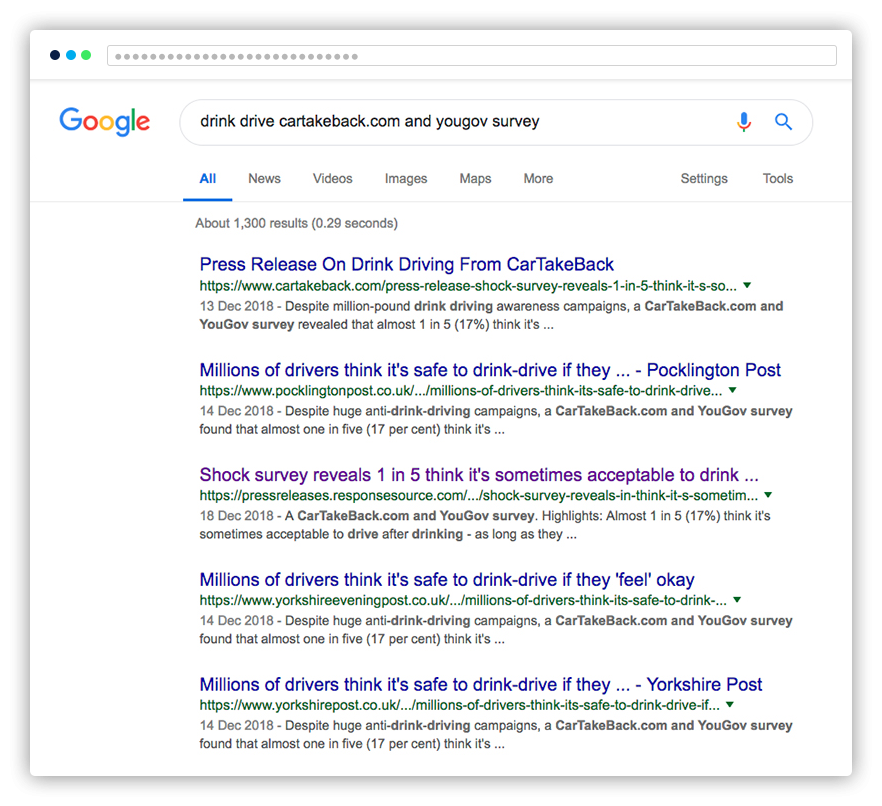
This screencap shows a snapshot of some of the coverage we received for a study commissioned on behalf of one of our clients, CarTakeBack. This was an example of an idea that generated large-scale interest from a variety of UK publications.
4. HAVE YOU CONDUCTED PROPER RESEARCH?
An absolute fundamental of any great piece of content is the quality of the research that’s gone into creating it. That could extend across any of the following areas:
Any information you need to source
How to get the best possible quotes
What similar pieces of content have been created - and how can you better those
How you can position your post to capture the most search traffic
Whether there’s the potential to get Featured Snippets with the post
These are just a few of the things to consider when producing any marketing piece, to get you in the mindset of whether a post really justifies production.
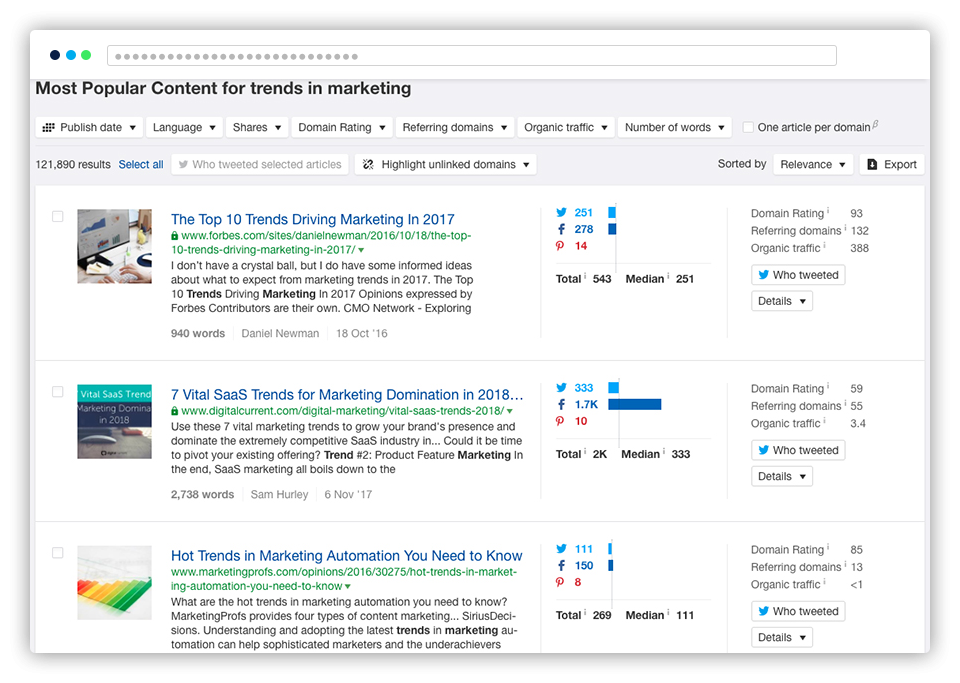
Here we can see an example of some of the results returned in ahrefs for content written around the suggested search.
5. WHO ARE YOU GOING TO PITCH IT TO?
If you’re going after any sort of external coverage for your content (backlinks, PR, press), then the organisation/people you’re going to pitch your content to should be absolutely central to your work.
If links back to your website are the end goal, the pitch process is arguably more important than the content itself. It’s easy to say that great content will attract leads naturally, but within the constraints of small budgets, it’s fair to say that you’re likely to need to do the legwork yourself. Make sure you identify:
The niche your content can fit within
Why external websites should link to it
Contacts at the domains you select at an early stage to strike up a relationship with
You don’t want to waste hours of your time producing a content piece designed for links, for it then to fall flat because there’s nowhere appropriate to actually provide coverage.
WRITING
6. HAVE YOU WRITTEN A STRONG INTRO?
Whatever you do, don’t be tempted to bury the most important part of your piece deep within your content. You might think that it’s a clever way to encourage people to read on, but you’re actually just more likely to lose their attention.
The real skill is in sharing the essence of the story you have to tell up front; compelling enough that it makes the reader want to understand more about the point you’ve made.
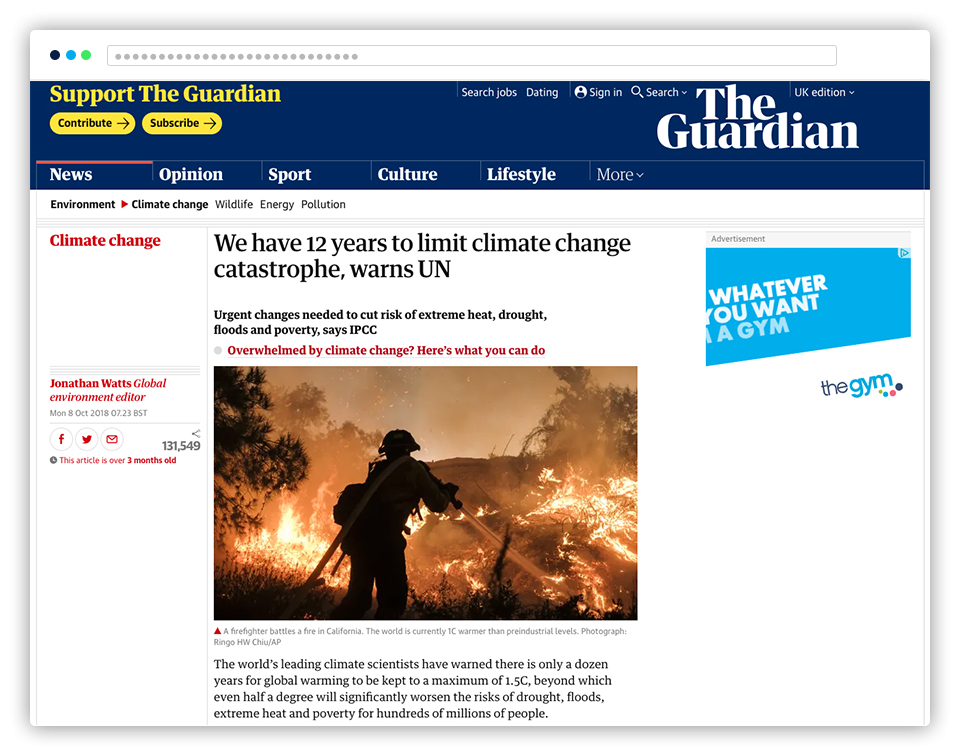
This is a great example of a strong introduction in the world of online journalism that explains all the key aspects of the story and compels you to read on. Think about how you can achieve a similar effect with your marketing content.
7. HAVE YOU WRITTEN A GREAT HEADLINE?
Don’t underestimate the importance of a great headline. In the world of instantaneous information, it could hold the key to someone reading your article or completely bypassing it.
Writing one is something of an art, since you want to grab attention without being misleading or spammy. A good practice is to write down 5-10 options for any piece you produce, go away, work on another task, then come back and see which one you think is most effective. It’s a technique that will help you to be remarkably ruthless.
It’s worth bearing in mind that if you work in SEO, you’re probably better than you think at writing headlines already; since crafting title tags is one of the most fundamental factors of on-site SEO.
Yes, you’re writing title tags to ensure Google crawls the page with your page’s targeted keywords in mind, but getting them in there in a way that doesn’t appear spammy - whilst serving the dual purpose of encouraging clicks - ties in pretty well with writing a headline that sells in a few words.

This is a strong example of an effective headline used within digital journalism, that asks a question of the reader; evoking an emotional response that encourages them to read on.
8. DOES IT HAVE A STRONG CONCLUSION?
Just as the intro is vital for ensuring someone reads your content through, the conclusion is vital for persuading them that it was worth their time. Essentially, if you’ve filled them with promise, make sure you deliver.
Look to summarise your findings concisely whilst catering any summary towards the format you’re writing for. If you’re being published on another blog, for example, you’ll want to consider how their readership may react differently to if you were summarising your opinions on your own website.
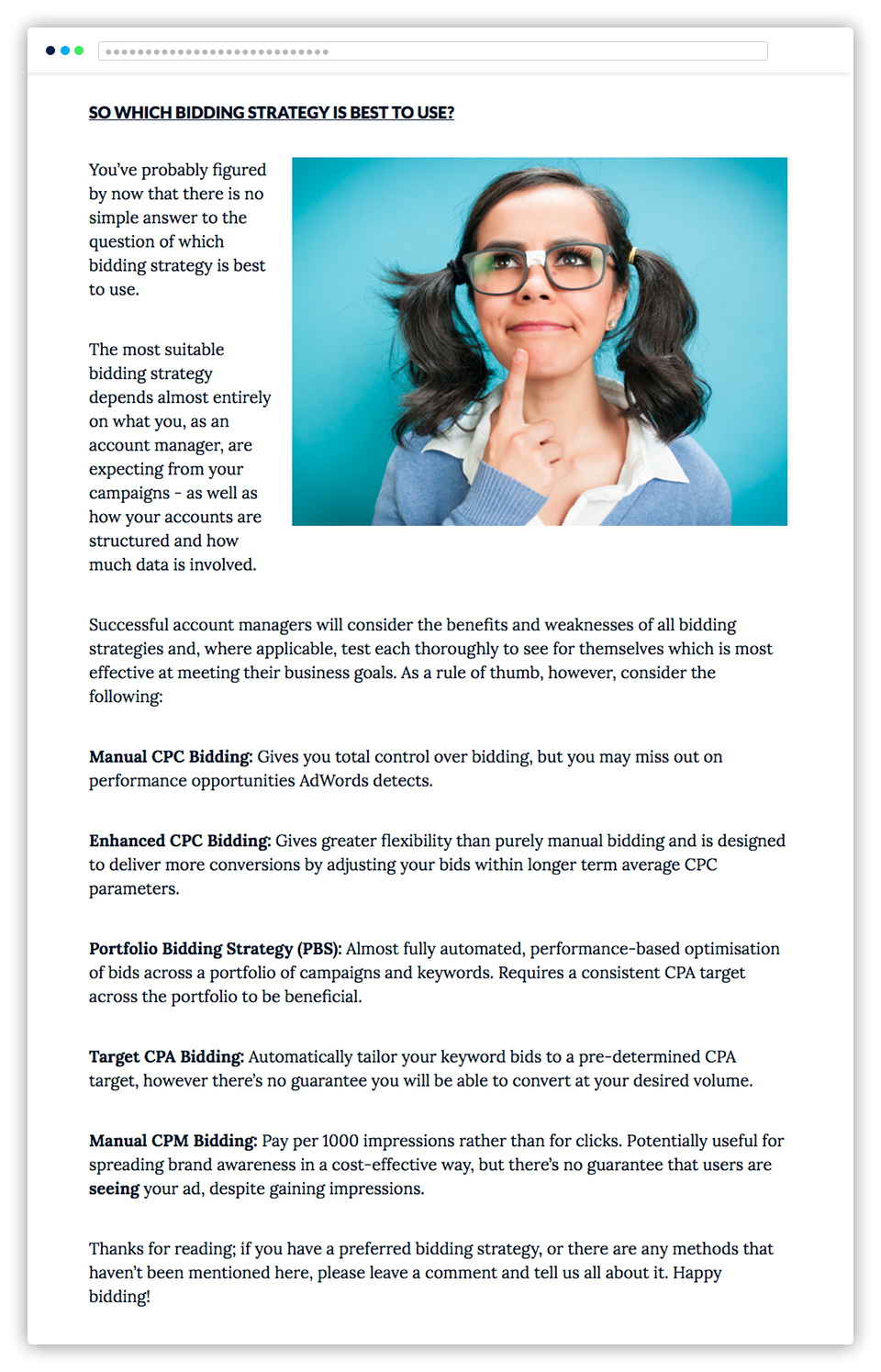
Here we see an example of a strong conclusion within a piece of marketing content on the Evoluted site surrounding Google Ads. The writer summarises the points made throughout the article and offers the key benefits of using each of the bidding strategies.
SUBSTANTIATING
9. HAVE YOU COVERED THE 5 W’S
Who? What? Where? When? Why? 5 Simple questions that can actually play an important part in focusing certain types of content (particularly news stories or original research pieces). If you can cover them all in the opening paragraph of the story you produce, even better.
Whilst they might not all be applicable in content marketing terms (such as ‘where’ for this blog), it’s worth running them against any posts you write all the same. If you can tick each point off, even if some don’t apply, then you’ll undoubtedly have a more focused piece that immediately grips the reader and compels them to read on through your post.
10. HAVE YOU QUANTIFIED YOUR CLAIMS WITH FACTS?
Stats, data and facts are always better than vague, unsubstantiated statements and opinions - and if they’re unique to your research, all the better.
Whilst the words that tie your content together are a vital part of the puzzle, your readers will ultimately want to know how you can quantify any claims and what sources enabled you to do so.
Write with this in mind and you’ll create content that carries more authority; ultimately helping you to earn the respect of the reader.
11. HAVE YOU INCLUDED QUOTES?
When I was training as a journalist, the importance of quotes was something that was repeated over and over again - with good reason. Not only do they add weight and insight to certain stories, they also give you something snappy to pitch your content with during the outreach process.
Clearly they aren’t necessary for every piece of content you produce - this post is a good example - but they have a place far more often than they don’t. They can also really help with outreach.
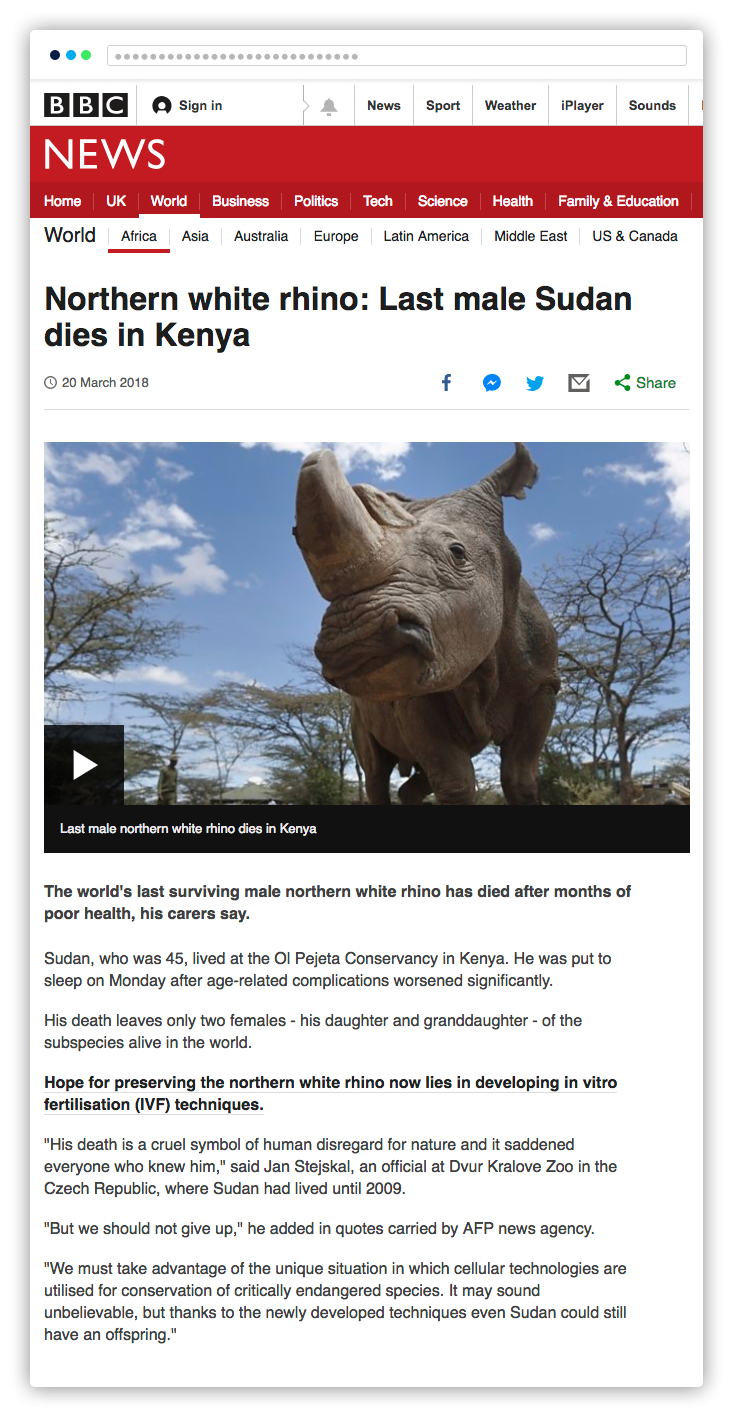
Within this BBC story, we have an example of powerful quotes used within a news piece. In just a few lines, we get a damning statement on human nature, as well as a solution to how the issue might still have cause for hope. If you’re creating a marketing piece with news at its heart, there is plenty to learn from this.
12. DO YOU HAVE STRONG SOURCES?
In addition to the quotes you use within your piece, you can also add weight and value to your work through the sources you use to substantiate any opinion, statements or facts that you make.
For example, you may be providing comment on a controversial industry topic; with a quote from someone relevant to the story. You can further add weight to that by substantiating their thoughts with some statistics from a reputable organisation, as well as the expertise of the person whose quotes you’re using.
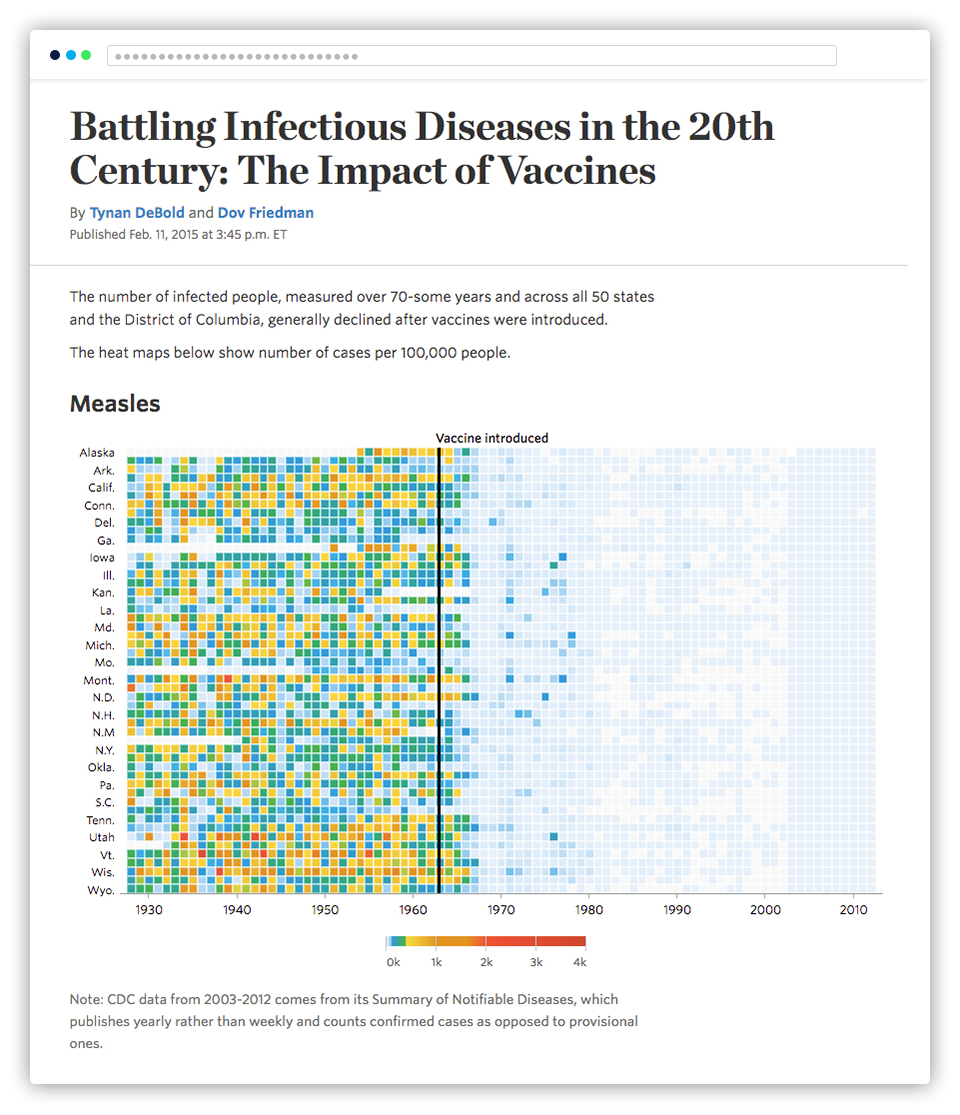
This Wall Street Journal article is a great example of a piece with strong sources that will encourage people to share and discuss the article. They have taken a strong source and enhanced it with engaging data visualisations.
13. DOES IT CONSIDER THE COUNTER ARGUMENT?
This one is definitely more of a ‘bear in mind’ than a necessity, since the need for impartiality will really depend on the format of the content you’re producing. You wouldn’t, for instance, be looking to make a piece promoting a retail clients’ clothing line impartial.
Where you would want to consider the counter-argument is for a study you’ve commissioned. In this scenario, whilst you may have eye-opening findings to share, you should also be looking to balance them with realism. This will ultimately make for a stronger, more well-rounded piece.
CHECKING
14. HAVE YOU BEEN RUTHLESS?
Long-form content can be great, but it isn’t always the answer. An example of where it might not work for you is the outreach process. If you’re looking to obtain a feature, it’s important to work within the constraints of the site you’re looking to pitch to. If you send them an article double the length of anything on their site, it’s unlikely they’ll provide coverage.
If you do produce a long-form content piece (such as this one), ensure you only include the information that’s needed. Originally, I had in excess of 30 questions to pose; but decided these 23 were the ones that offered genuine value to the reader.
15. HAVE YOU SHOWN ATTENTION TO DETAIL?
Journalists are judged not just on the quality of their sources, but also on how well they write. It doesn’t matter how long you’ve been producing content for, the basics such as spelling and grammar should be just as important to you as they always were.
Whilst it’s true that some people may be more forgiving - and also that every person makes the occasional error - it’s undeniable that if your copy is really riddled with mistakes, you might lose the respect of your audience.
You also need to show the same attention to detail in the information you're providing. Make sure it’s well sourced and backed up by fact where required.
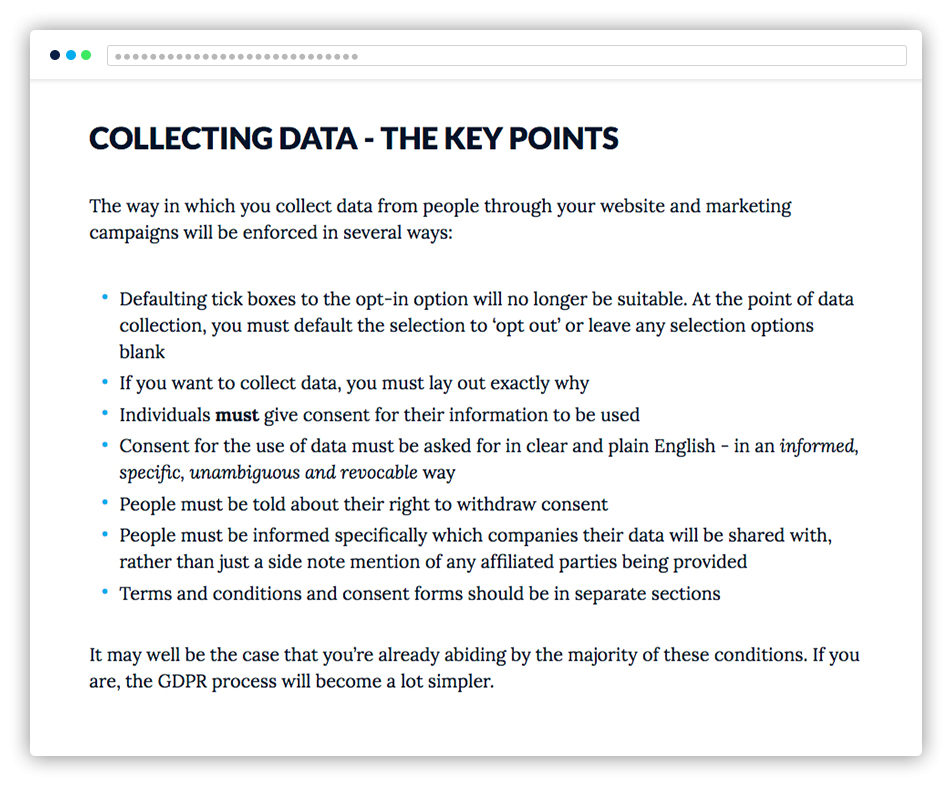
It was important this piece we put together around GDPR, websites and marketing was entirely accurate. We wanted to educate clients and external readers around the subject so it was important the information we presented was exactly in line with the regulations.
16. HAVE YOU CONSIDERED THE ETHICS?
It’s important to create content that is truthful and founded in fact. You also need to remember that as a writer, you are attempting to educate your audience around a certain area - so you have a duty to do this well.
There may of course be no major ethical issues related to the content you’re creating, but it’s worth spending a few minutes assessing it all the same, to gauge whether there are. It may help you to make tweaks to your post that could ultimately earn you greater respect from the reader.
PITCHING
17. HAVE YOU PROPERLY CONSIDERED THE AUDIENCE?
When it comes to pitching your content to external publications, it’s important to bear in mind that their audience will have different needs to your own. Here are some of the ways this could affect the pitching process:
You want to replace a link: You’ve identified a website that’s linking out to another site, but think you can do a better job than the site being linked to.
Make sure to consider why that piece was chosen in the first place, before steaming ahead without understanding how to appeal to the site you want to link to you instead. What’s missing? What have the site they’re currently linking to done wrong that you could improve upon to the benefit of their audience?
You want to guest post: If you’re looking to gain coverage for a post on another site, rather than hosting it on your own website, you have to show that you understand the readership of the site you’re pitching to.
You can then create a piece tailor made for their audience. It really goes without saying, but don’t be looking to pitch a post that’s already published on your site; as this raises red flags for duplication. At a minimum show the post and explain how you want to re-work it significantly for their audience.
You’ve created content for mass sharing: If your aim is to generate links en-masse, rather than via one specific site, then you need to ensure that your content is ‘neutral’ enough to gain coverage regardless of the publication. If you weight it too far in one direction, you could risk isolating the content from being linked to.
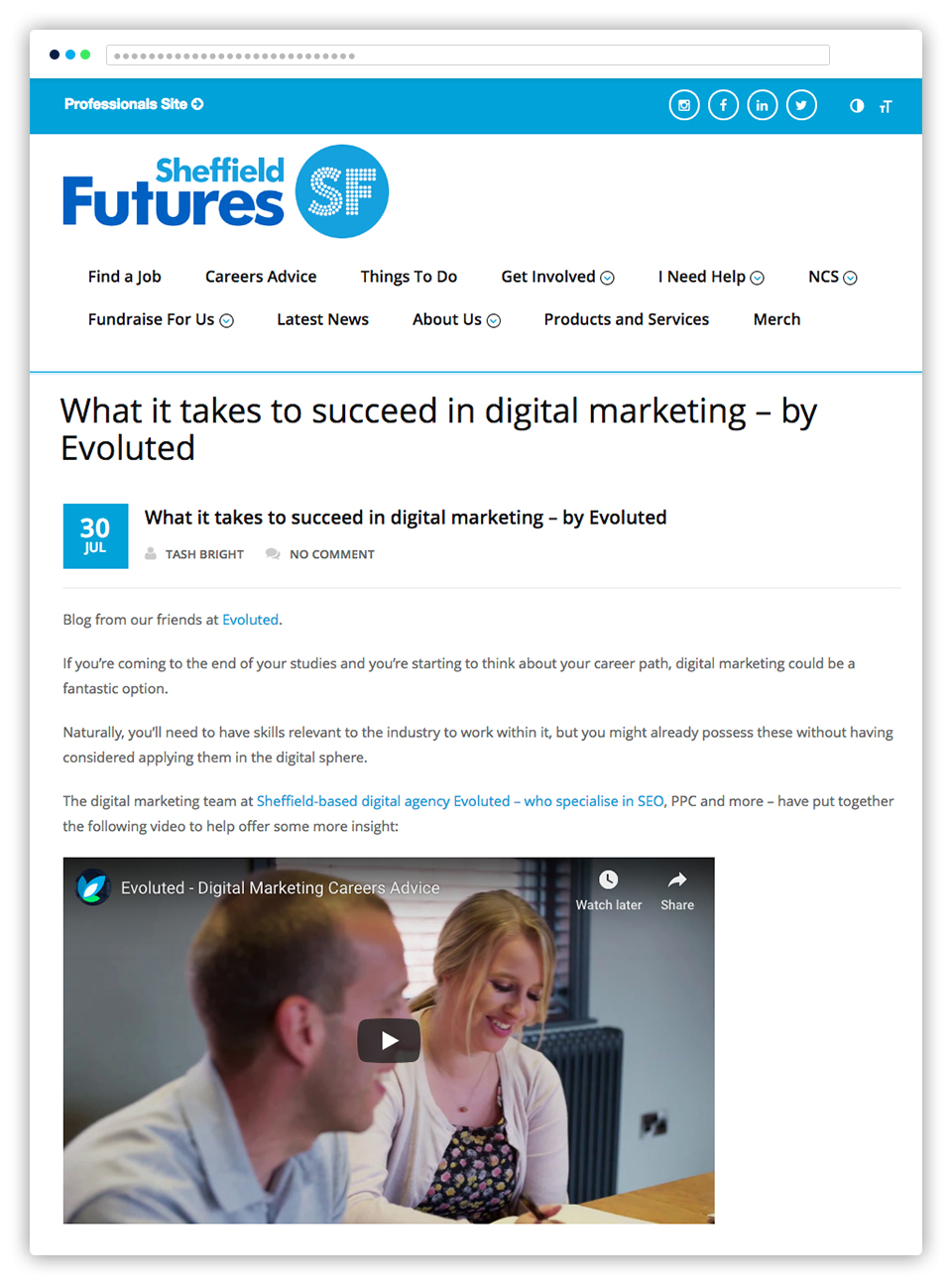
We put this article together for Sheffield Futures, as a means to help their audience understand some of the useful things they can do to get into a career in marketing. It was important to position the content so that it worked for the readership.
18. WILL IT PROVOKE A REACTION?
Content that provokes a reaction will spark discussion. Whilst that isn’t particularly groundbreaking insight, it can be worth reminding yourself of it occasionally. If you can add something into your content that’s designed to evoke emotion of any kind then it might just be the differential behind someone providing coverage of it or not.
19. IS IT AN EXCLUSIVE?
With strong backlinks still fundamental to SEO success, the ‘hook’ to your story is likely to be the key to preventing it crashing and burning. A great way to ensure you have a strong hook is to run with the creation of content based around something exclusive. Examples of this that could work with your marketing content include:
New quotes around a relevant topic that are likely to spark discussion
Facts and figures from a survey you’ve commissioned
Interesting data you’ve sourced and presented in a unique way
In 2018, we put together a video featuring the thoughts of our marketing team on what it takes to succeed in digital marketing. We used this original content to gain backlinks from external providers and capture organic search traffic.
20. HAVE YOU PROMOTED IT PROPERLY?
Hopefully, you’ll already have an idea of your promotion strategy before any content is finalised. This way, you can ensure a quicker turnaround with the outreach process. More importantly, you can secure interest in the article you’re producing to justify investing the time taken to create it.
When promoting your content, some of the things you could be doing include:
Re-evaluating your ‘pitch list’ to see whether it can be added to
Testing different outreach approaches and focusing further on successful areas
Producing a killer press release that sells the idea in question with great effect
Whatever your plan for outreach is, you should be thinking about how you’re going to get coverage for your content right throughout the creation process. Be prepared to change your idea as a means to gaining a valuable link.
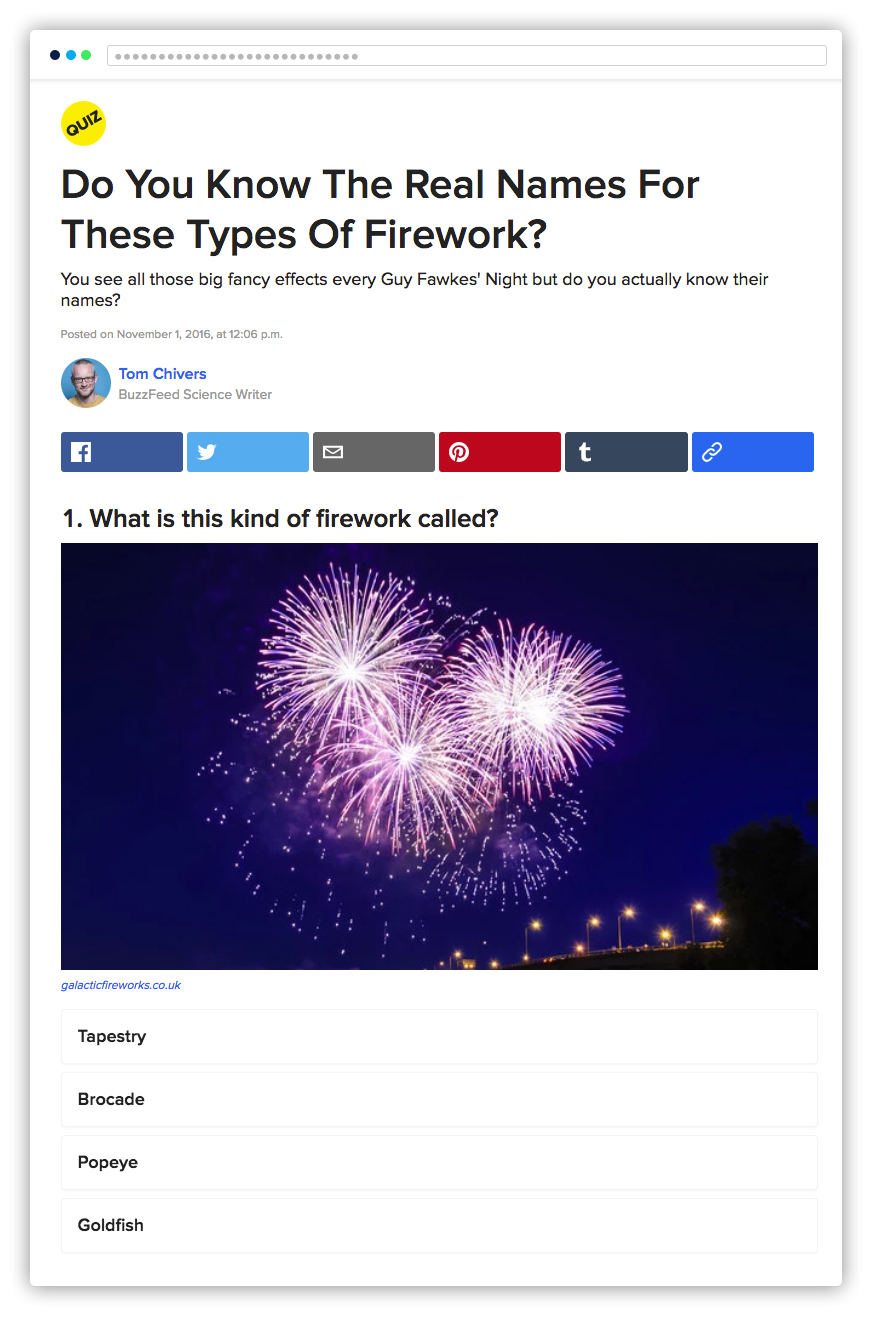
This link we achieved from Buzzfeed, on behalf of our client Galactic Fireworks, brought great coverage for the client; providing a boost ahead of their peak season. On request from Buzzfeed, we quickly created additional imagery in order to secure the backlink.
MEASURING
21. DID YOU ACHIEVE THE DESIRED AIM?
When you set out with your content, what was your aim? Was it to acquire backlinks? Or to generate high volumes of organic traffic? Or maybe a combination of the two?
Whatever the case, you need to track performance once you’ve finished the creation and outreach stages, otherwise, you risk having completely wasted your time. You also need to be able to justify the work to those that have a stake in it.
Even if the piece hasn’t been as successful as you hoped, it’s vital to analyse exactly what you did to understand what may have gone wrong and learn how you would better go about the process next time.
Similarly, if the post has achieved the desired goals, don’t be tempted to rest on your laurels. Further finesse the formula that brought you success and go again!
BEYOND
22. COULD IT BE TAKEN FURTHER?
Even the best of content can be improved upon in time. If you have posts that bring in exceptional levels of traffic, maybe they could perform even better. Or, with a few minor tweaks, perhaps they could gain valuable search positions. There may even be the potential to run a follow-up piece that adds to the success of the original piece.
In addition, even if the content is hosted elsewhere, there could still be ways to further the idea; such as going back to the organisation you worked with to see if they’d be interested in content that expands upon what they already have.
A great example of how you can be successful with further improving a piece of content that’s achieved a solid ranking on the first page of Google, albeit further down the page, is through a Featured Snippet. With some tweaks to formatting and some extra copy, you could jump right to #0 by securing a Featured Snippet result.
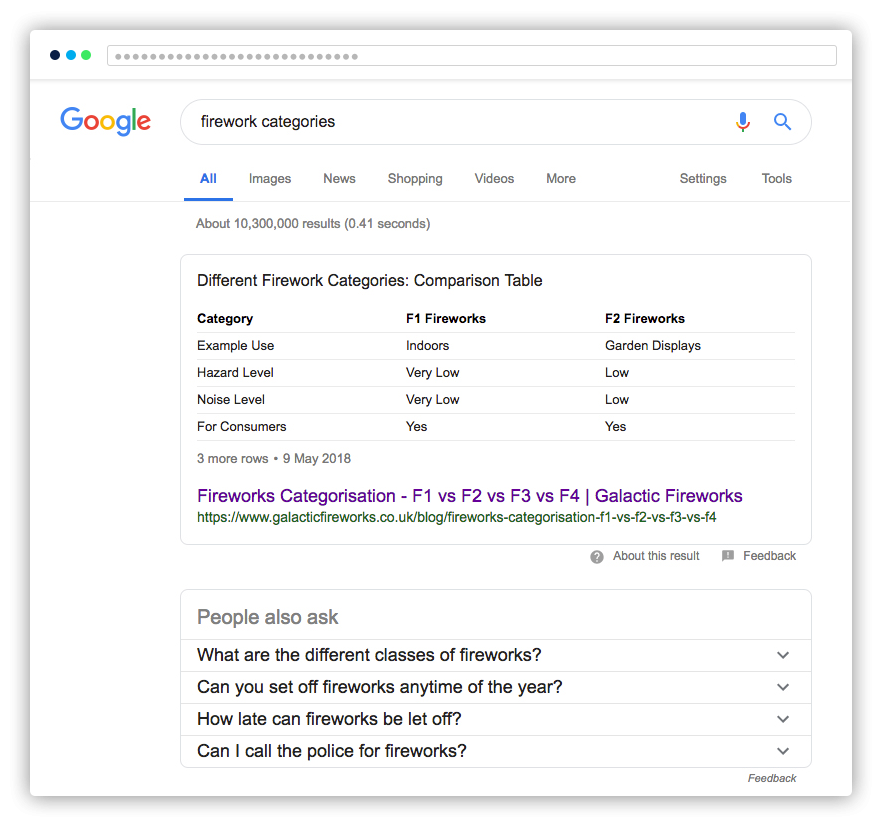
Here we can see an example of how making adjustments to a piece of content can ensure you leapfrog your competitors to capture the top position in the search results through a Featured Snippet.
23. ARE YOU MAINTAINING RELATIONSHIPS?
If the content you created enabled you to spark up a relationship with a journalist, external publication or website owner, it’s worth taking the time to nurture that relationship moving forward. That way, if the person in question needs comment or some content in the future, you’ll be right at the forefront of their mind.
THAT’S IT!
Thanks for reading the post - hopefully you’ll have found some inspiration for your content production processes. Remember:
Plan and research, ensuring to work within the constraints of the budget whilst making your content newsworthy. Make sure you have a clear goal in mind.
Write with flair, utilising a strong intro and conclusion.
Substantiate your content with strong sources, facts and quotes, taking care to consider both sides of any potential debate.
Be ruthless and only include the information required. Check your content for errors and consider any ethical implications.
Consider the exclusivity of your content and whether it will evoke a reaction. Use this to strengthen your pitch and look to satisfy your initial goals.
Measure the outcome of your campaign and use the discovery to influence future work.
Revisit the content and identify whether there could be valuable improvements to be made.
If you require expert support with your content marketing and digital PR campaigns, check out our content and digital PR services today.









